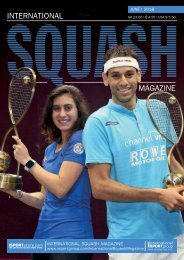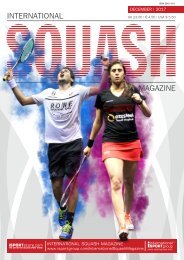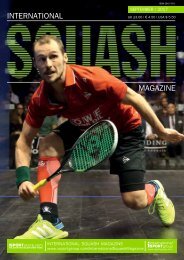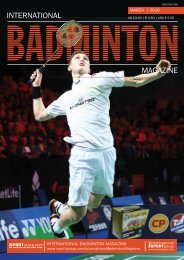International Squash Magazine – April 2020
You also want an ePaper? Increase the reach of your titles
YUMPU automatically turns print PDFs into web optimized ePapers that Google loves.
COACHING & INSTRUCTION:
DEVELOPING JUNIORS
DEVELOPINGJUNIORS
By David Campion
England Squash National Coach
& Dunlop Ambassador
Coaching is an art form and you could argue that it is even more
challenging in an open skill sport such as squash, where playing
requires not only physical motor skills but cognitive skills such as
problem-solving and decision-making.
England National Coach David Campion
explains why the tactical elements
and development of a player is every
bit as important as their technical
development.
The research will tell you that you
don’t really need to specialise early
to be Word Class, perhaps that is
the case in closed-skill sports such
as rowing or cycling, but in a highly
skilled racket sport such as squash, it`s
not impossible, just less likely. In any
case, those that did start later and do
`make it`, I suspect were learning their
physical motor and cognitive skills in
other sports from an early age.
So, where does it all start?
The great players of today all came from
somewhere and for the most part it
starts in their local club, simply because
one of their parents played or a school
friend introduced them to the game.
Developing successful juniors starts in
the clubs and counties where your coach
or volunteers can provide the type of
environment that offers 3 simple things:
Frequency
A lot of clubs focus solely on their
Saturday morning junior club and don’t
provide much of a structure for weekday
after school sessions. Yes, they may
have great numbers on a Saturday
morning where the kids get to play
for one hour, but who gets any better
on one hour per week? Add weekday
sessions for those that want to progress
from the Saturday morning session.
Fun
All future champions initially go through
a ‘romance’ phase early in their careers,
meaning that they seem to fall in
love with their sport and therefore
become very passionate about their
performance. The first coach is critical
to the climate to hook the player into
the sport.
Environment
Create an environment that is fun, has
structure, has frequency of sessions
with high numbers of players and still
manages to be affordable for parents
regardless of their situation.
To get frequency it needs to be
affordable. For the cost of one individual
lesson of an hour per week you could
perhaps have four group sessions that
gives you four or five hours of hitting
whilst learning decision making i.e. shot
selection, height, pace, direction along
with the physical motor skills. You are
firing up your neural pathways at a
far faster rate simply because you are
playing more! Add in a coach who knows
how to set up the practises and games
that will enhance this and the rate of
development is even faster. A lot like
dialup vs. fibre broadband.
I`m not dismissing the case for
individual coaching, it plays a vital
role of course, but in the early years
if you want to develop young players,
they need to hit lots of balls whilst
developing their cognitive skills. No
need to isolate too much at this stage.
Build their skills within the practises.
Just make sure their grip is `within a
range` that allows them to execute the
variety of shots that the practices and
conditions demand. Once the grip is in
place the rest should follow, overlook
that and it will be detrimental to their
development.
The current top 10 men and women in
squash all have very good technique, all
very different as well, so who is to say
what correct technique is? One thing
they do better than everyone else, is
they play the right shot at the right
time; they are matching their cognitive
skills with their physical motor skills
(technique). Quite simply its `game
intelligence`.
How can we learn ‘Game
intelligence’?
There is no absolute fact about anything
as all top sportspeople achieve great
things in their own personal way,
however if you can mimic the range of
variations that you will experience in a
match, you shouldn’t go too far wrong.
You can simply set up a practise or
condition game which forces a player
to land the ball in a particular area of
the court i.e. within the confines of
the width of the service box, or above
the cut line to force them to hit high
for example. This will force technical
adaptations that the learner must solve
without you telling them what to do.
This self-guided discovery provides them
with intrinsic feedback, meaning they
can repeat it if they did it well - they
know how it felt. If you give them a few
options within the game or the practise
and they are up against an opponent,
as opposed to you feeding, you are
bringing in decision making based on
their opponents position or type of shot
they have just hit. It brings in a whole
new dimension without isolating just the
technical execution of the shot.
Make sure you build the foundations
first with simple practices that will
20 | April 2020 IINTERNATIONALSQUASHMAGAZINE
www.isportgroup.com/InternationalSquashMagazine















